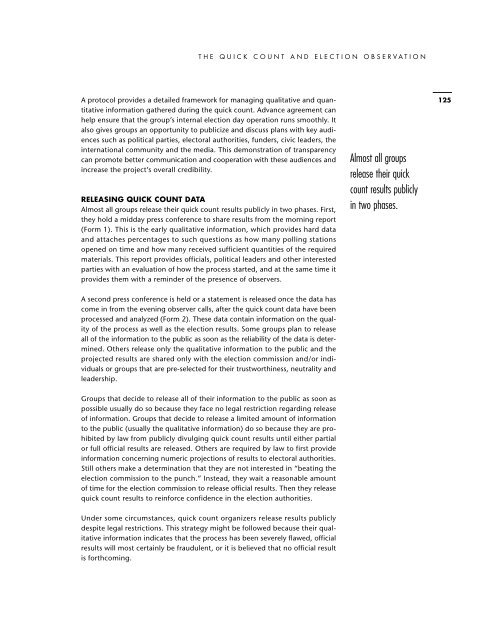The Quick Count and Election Observation
The Quick Count and Election Observation
The Quick Count and Election Observation
Create successful ePaper yourself
Turn your PDF publications into a flip-book with our unique Google optimized e-Paper software.
THE QUICK COUNT AND ELECTION OBSERVATION<br />
A protocol provides a detailed framework for managing qualitative <strong>and</strong> quantitative<br />
information gathered during the quick count. Advance agreement can<br />
help ensure that the group’s internal election day operation runs smoothly. It<br />
also gives groups an opportunity to publicize <strong>and</strong> discuss plans with key audiences<br />
such as political parties, electoral authorities, funders, civic leaders, the<br />
international community <strong>and</strong> the media. This demonstration of transparency<br />
can promote better communication <strong>and</strong> cooperation with these audiences <strong>and</strong><br />
increase the project’s overall credibility.<br />
RELEASING QUICK COUNT DATA<br />
Almost all groups release their quick count results publicly in two phases. First,<br />
they hold a midday press conference to share results from the morning report<br />
(Form 1). This is the early qualitative information, which provides hard data<br />
<strong>and</strong> attaches percentages to such questions as how many polling stations<br />
opened on time <strong>and</strong> how many received sufficient quantities of the required<br />
materials. This report provides officials, political leaders <strong>and</strong> other interested<br />
parties with an evaluation of how the process started, <strong>and</strong> at the same time it<br />
provides them with a reminder of the presence of observers.<br />
Almost all groups<br />
release their quick<br />
count results publicly<br />
in two phases.<br />
125<br />
A second press conference is held or a statement is released once the data has<br />
come in from the evening observer calls, after the quick count data have been<br />
processed <strong>and</strong> analyzed (Form 2). <strong>The</strong>se data contain information on the quality<br />
of the process as well as the election results. Some groups plan to release<br />
all of the information to the public as soon as the reliability of the data is determined.<br />
Others release only the qualitative information to the public <strong>and</strong> the<br />
projected results are shared only with the election commission <strong>and</strong>/or individuals<br />
or groups that are pre-selected for their trustworthiness, neutrality <strong>and</strong><br />
leadership.<br />
Groups that decide to release all of their information to the public as soon as<br />
possible usually do so because they face no legal restriction regarding release<br />
of information. Groups that decide to release a limited amount of information<br />
to the public (usually the qualitative information) do so because they are prohibited<br />
by law from publicly divulging quick count results until either partial<br />
or full official results are released. Others are required by law to first provide<br />
information concerning numeric projections of results to electoral authorities.<br />
Still others make a determination that they are not interested in “beating the<br />
election commission to the punch.” Instead, they wait a reasonable amount<br />
of time for the election commission to release official results. <strong>The</strong>n they release<br />
quick count results to reinforce confidence in the election authorities.<br />
Under some circumstances, quick count organizers release results publicly<br />
despite legal restrictions. This strategy might be followed because their qualitative<br />
information indicates that the process has been severely flawed, official<br />
results will most certainly be fraudulent, or it is believed that no official result<br />
is forthcoming.


